This post may contain affiliate links. We may receive a small commission, at no cost to you, if you make a purchase. Read Disclosure.
Hidden amidst the winding canals and mysterious streets of Venice, is a building known for its beauty and grandeur.
The Doge’s Palace is an architectural marvel that showcases the best of Venetian Gothic styles, both on the outside and inside.
It’s one of the biggest attractions in Venice, and is famous for its opulent rooms, royal chambers, and pieces of exquisite artwork throughout.
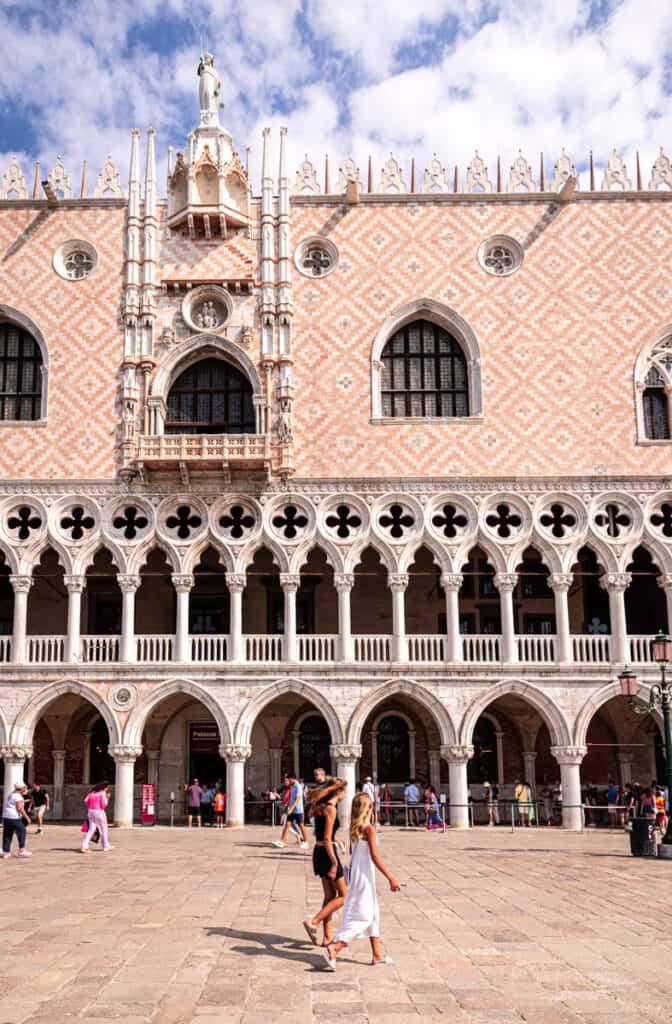
You can wander through the Bridge of Sighs and listen out for the faint sound of prisoners’ hopes and dreams whispered as you cross into the prison, or simply lose yourself in the romance of it all.
In this guide, we’ve shared how to visit The Doge’s Palace in the best way possible – without the crowds!
This is not just a building; it’s a place where stories and legends come to life. It’s important to note that the Doge’s Palace is also called Palazzo Ducale.
Is The Doge’s Palace Worth Visiting?
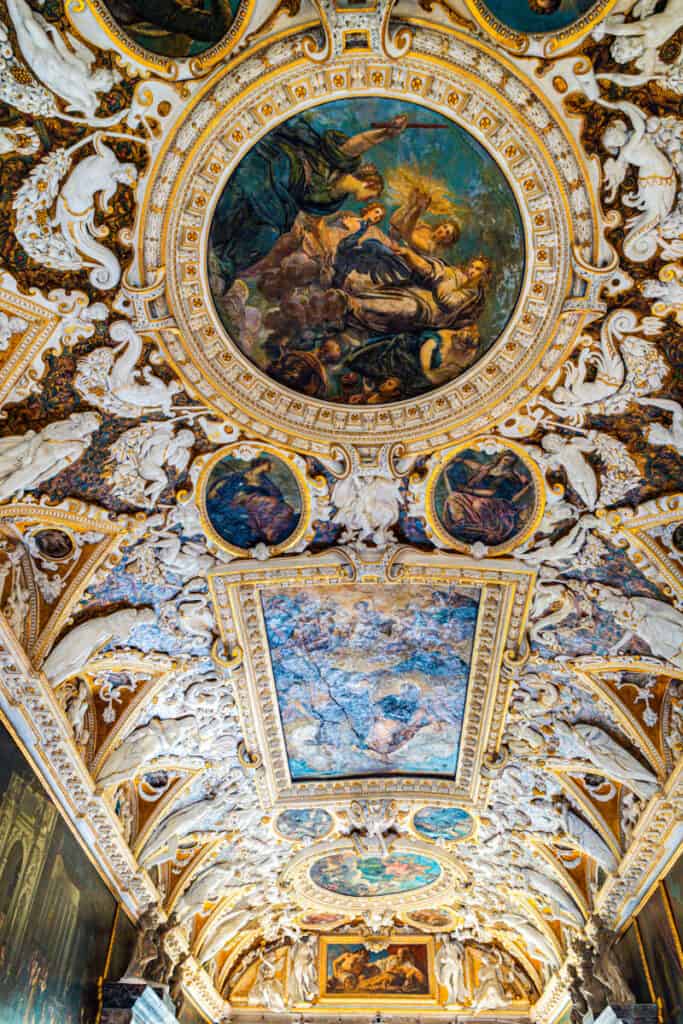
This was the question I asked myself as I planned my one-day itinerary for Venice. Should we fit it in or skip it?
As it’s such a famous building and once-important part of Venetian history, I decided to, BUT making sure to book the first tour of the day.
It was really the only time we had for it anyway, and I wanted to have less chance of lines so I could better control the rest of the day as we had booked in tours, I did not want to be late for.
The Doge’s Palace ended up being one of my favorite things to do in Venice.
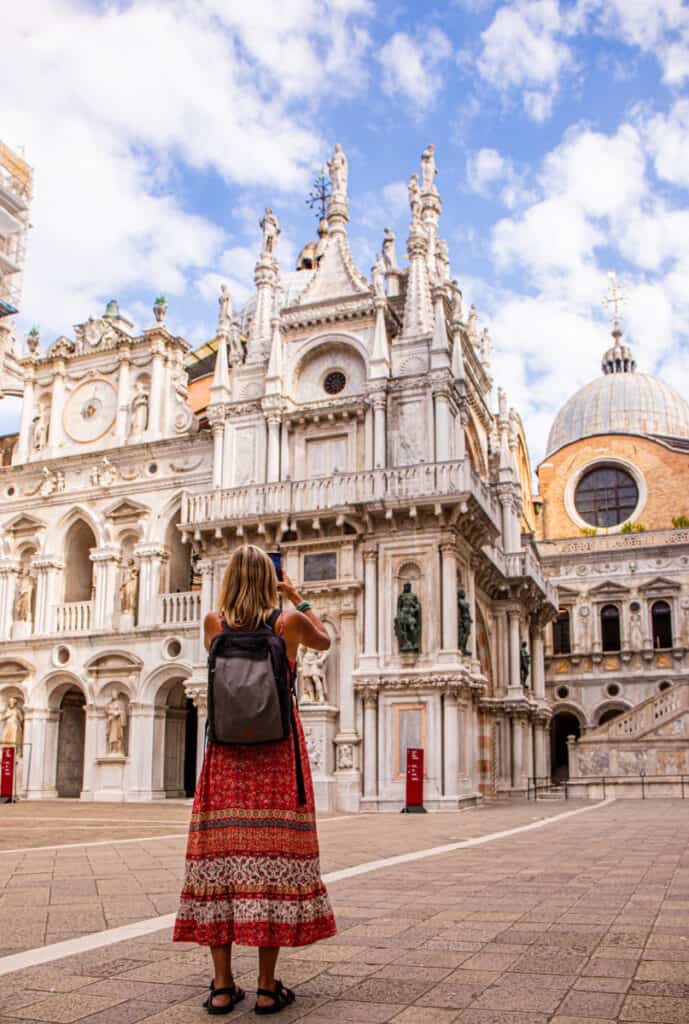
BUT, be warned, I share with you the tip below about getting here early. I have friends who visited Doge’s Palace and didn’t enjoy it much as they were fighting through crowds.
Like we experienced at the Palace of Versailles, having the Hall of Mirrors all to ourselves, timing is everything when traveling in Europe, especially popular destinations like Venice.
So, if you time it right, I think the Doge’s Palace is worth visiting.
History of The Doge’s Palace
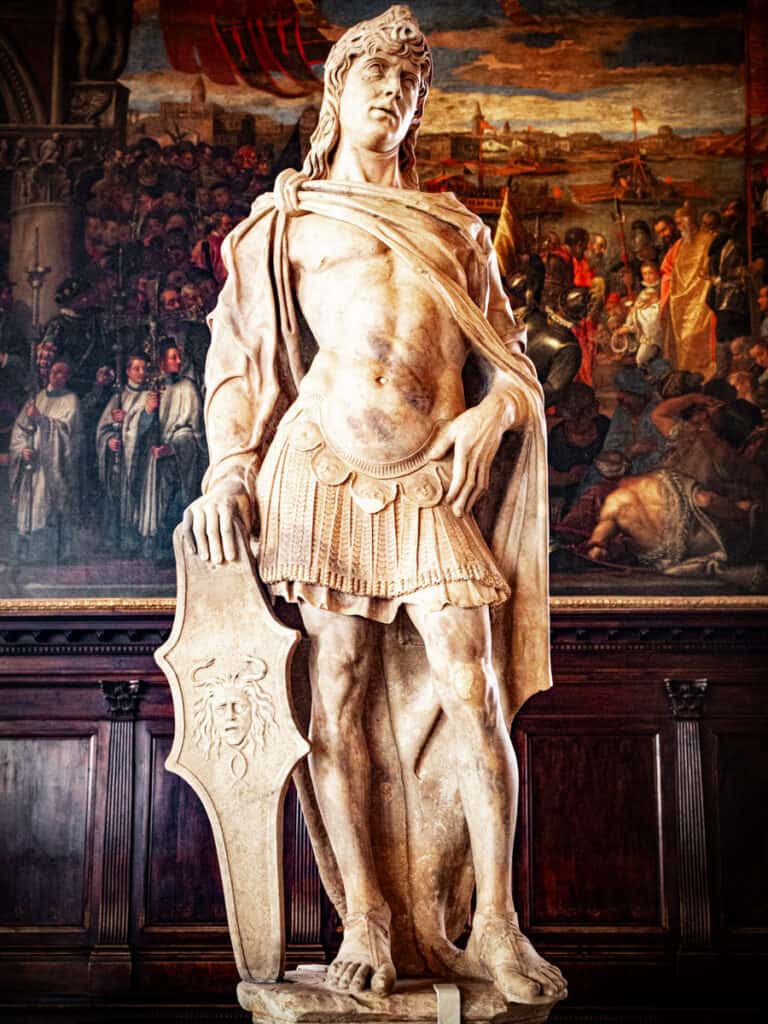
The Doge’s Palace, built in the 14th century, was the official residence of the Doge, the supreme authority of the republic.
The palace was built using Gothic Venetian styles over the smaller palace built by Doge Ziani, and very little of this original palace remains. What you see today is the 14th century architecture that was commissioned by Doge Bartolomeo Gradenigo.
He built the part of the palace facing the lagoon and also commissioned artist Guariento to decorate the East Wall of the Great Council Chamber with large frescoes, making them the oldest paintings in the palace complex.
Each Doge had been extended and added to the palace over the years, including the construction of the prison in the late 16th century, which was linked to the palace by the Bridge of Sighs.
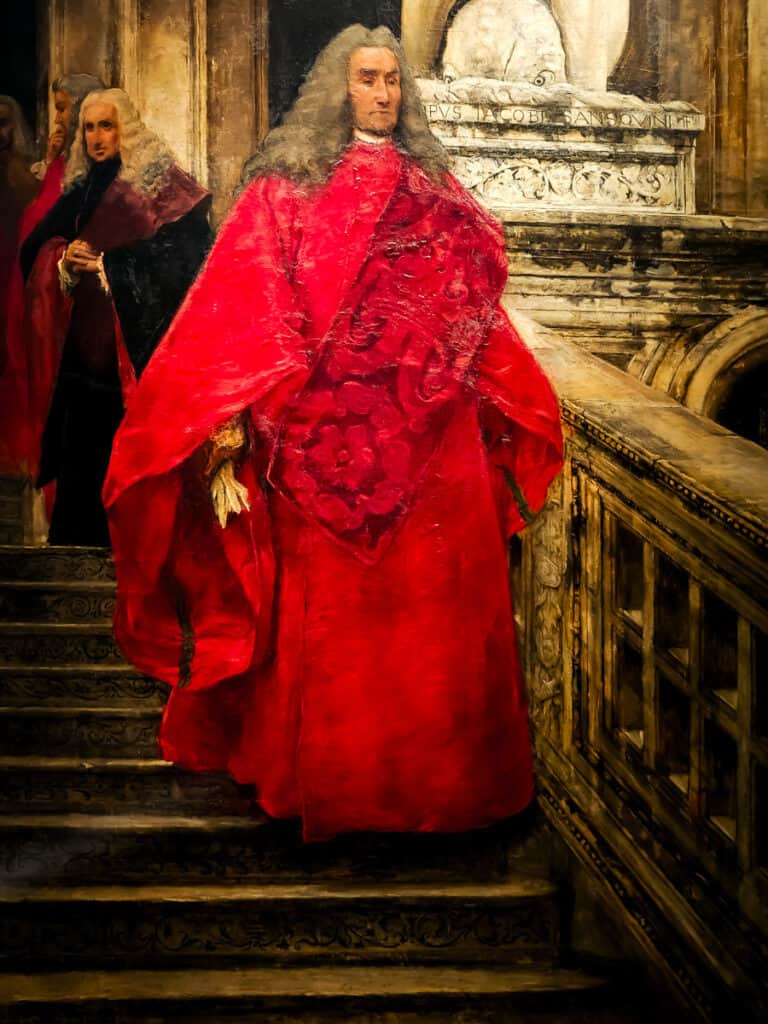
After the fall of the Venetian Republic in 1797, it fell into the hands of many political figures throughout the years, remaining the offices of government until the 19th century, when the Italian government restored the building and moved the government offices out of the building (except the State Office for the Protection of Historical Monuments, which is still there), and eventually opened the palace as a museum in 1923.
Today, visitors can walk the opulent halls and chambers that were once the place where political decisions were made and public affairs were managed, shaping the city of Venice into the marvel it is today.
How to Get to The Doge’s Palace
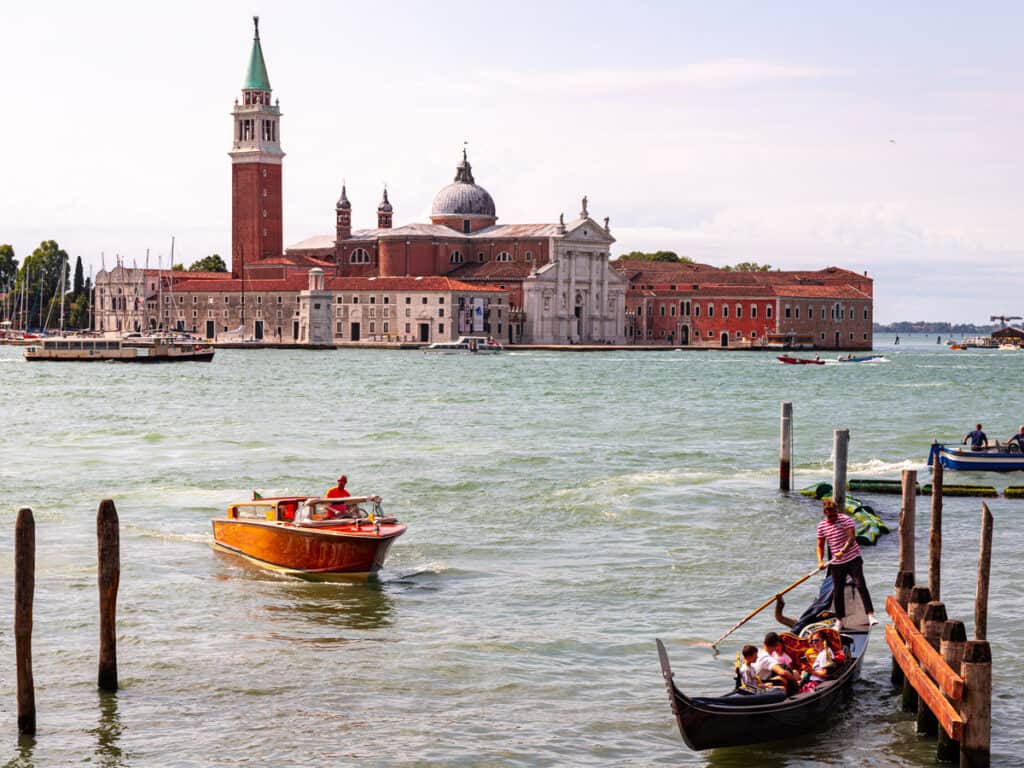
The palace sits on the edge of the illustrious St. Mark’s Square. This central point in Venice is easy to get to from wherever your hotel is based. Venice is a very walkable city, but if you don’t want to walk, you can take a water bus or ferry.
Opening Hours & Fees
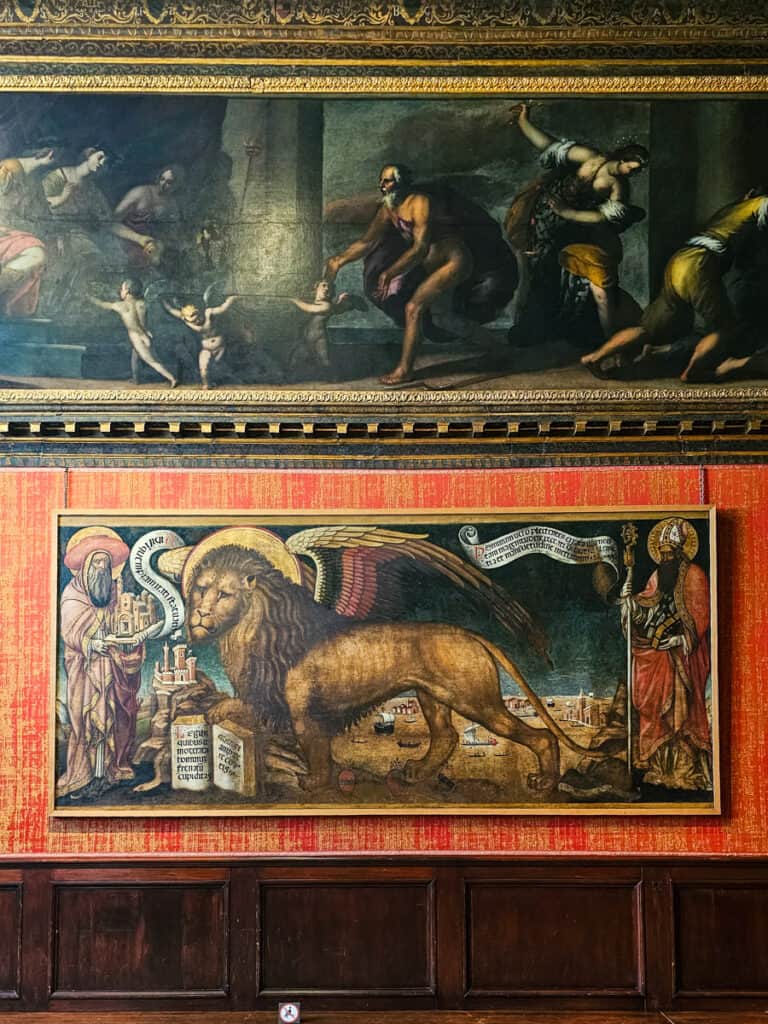
The palace is open every day from 9.00am until 7.00pm. General admission is €30.00 for adults and €16 for children, seniors and students.
You can also purchase the Museum Pass, which grants you entrance to The Doge’s Palace as well as Correr Museum (plus temporary exhibitions), Archaeological Museum, Monumental Rooms of the Marciana Library, as well as other Venice Civic Museums such as Ca ‘Rezzonico, Murano Glass Museum, Museum of National History and the Burano Lace Museum.
The museum pass is €45.00 for adults and is definitely worth it if you plan to visit other museums in Venice.
An alternative is the Venice Pass, which gives you the fast pass ticket to Doge’s Palace, St Mark’s Basilica and a gondola ride.
Getting Tickets to Doge’s Palace
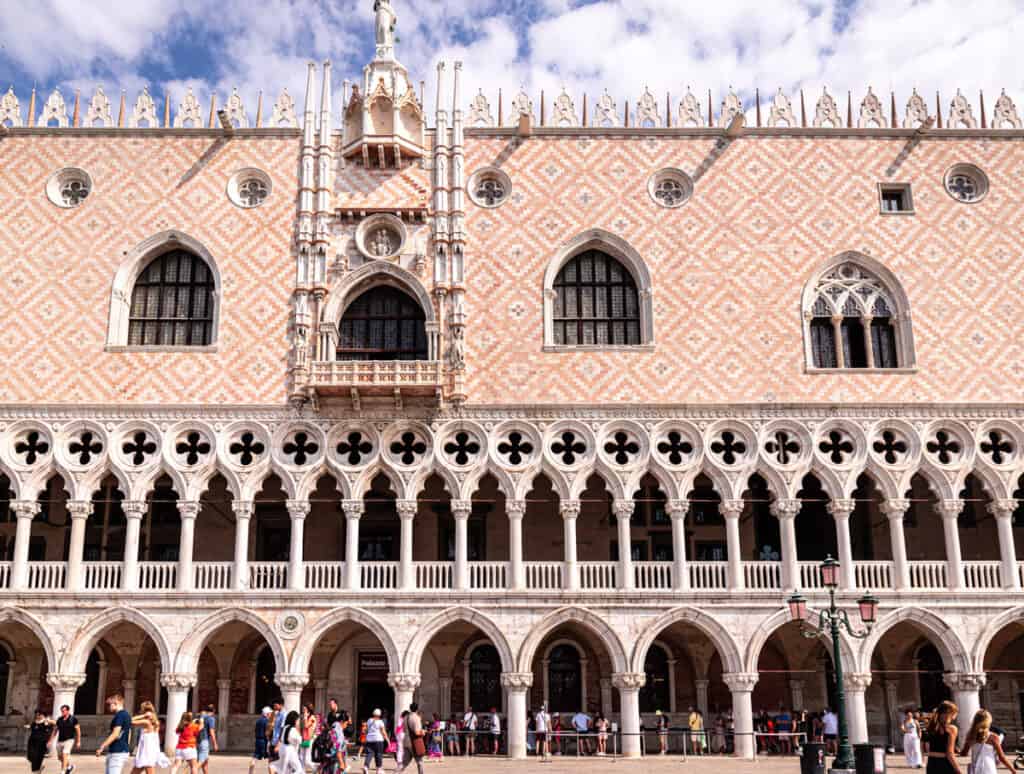
I would purchase tickets to the Doge’s Palace via tour and ticket booking sites, rather than directly through the Doge’s and definitely purchase in advance. The Doge’s website is confusing, they tend to sell out quickly, AND they are non-refundable.
I’d rather the security of knowing that I can cancel the tickets, if need be, up to 24 hours in advance, I can easily access my mobile ticket through the app to show at the door, and I have more options to get the time slot or tour I want.
We purchased our tickets for Doge’s Palace on Tiqets. It was the only booking site that had entry ticket availability for the 9am time slot. They also have last minute, fast-track tickets available for slightly more if you get stuck.
Here are more options:
- Reserved Time slot via Get Your Guide. For some reason their time slots start at 10am. It’s an alternative option if needed.
- However, the guided tours via Get Your Guide do start at 9am.
- Doge’s Palace + St. Mark’s Basilica: Bundle
- Doge’s Palace Skip-the-Line Ticket with Guidebook
Tours of The Doge’s Palace
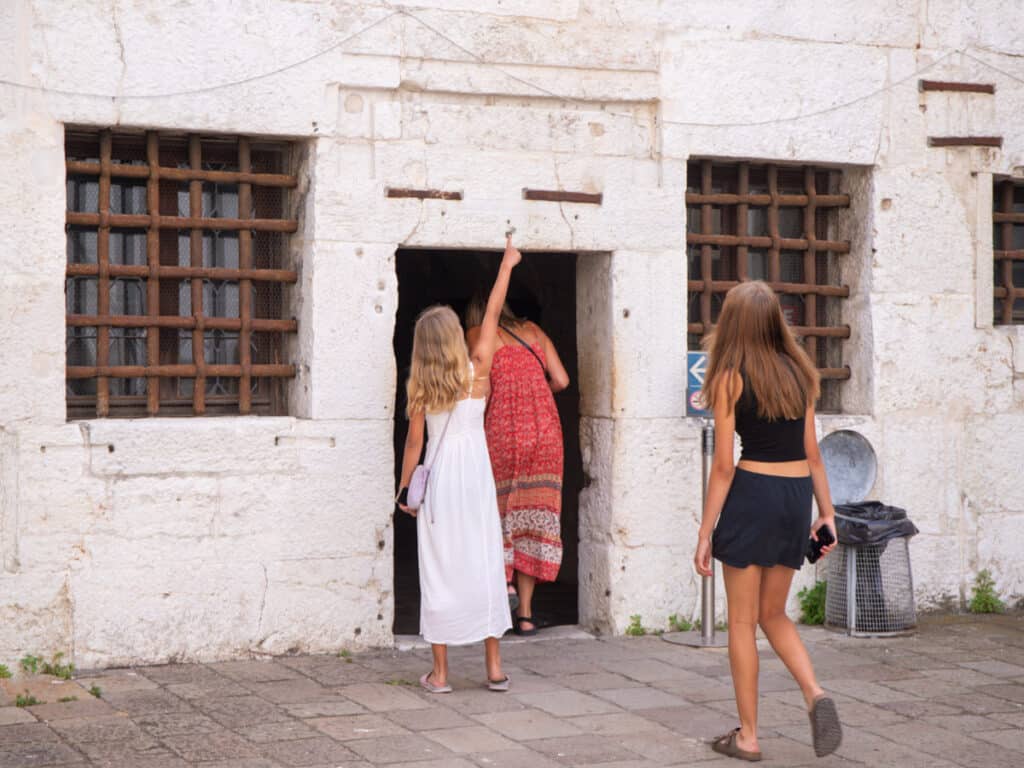
Another way to explore the palace is on a guided tour, which is the best way to see the palace quickly if you only have one day in Venice. There are several different types of tours you can take of the palace, including…
The Secret Itinerary Tour
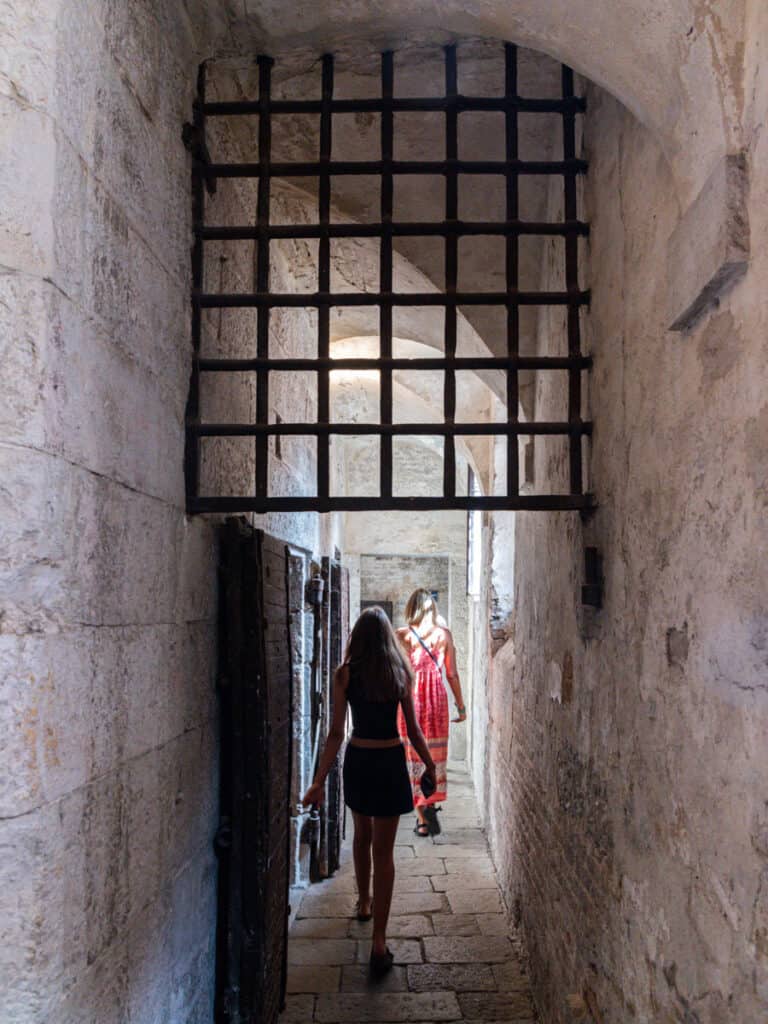
The Secret Itinerary tour takes you to the rooms and chambers which were once used by the Venetian administration. These spaces are where you can uncover the civil and political history of the Venice Republic, and learn about its organizations, and the way in which they governed.
The small group tour takes place daily at 10.00am, 11.30am and 1.00pm in English and has a maximum of 25 people on the tour, so be sure to book in advance to avoid missing out.
This tour takes 1 hour and 15 minutes and also grants you access to the Doge’s Palace without a guide, so you can explore the rest of the palace yourself after the tour. See rates and availability for this VIP tour here.
The Doge’s Treasure Tour
This tour takes you to the rooms of the palace that were used by the Doge, located in the wing next to the St Mark’s Basilica.
This tour lasts for 1 hour 15 minutes and has a maximum of 10 people per tour. These tours take place in English at 11.00am and 4.00pm daily. Book your tickets here.
Other Guided Tours
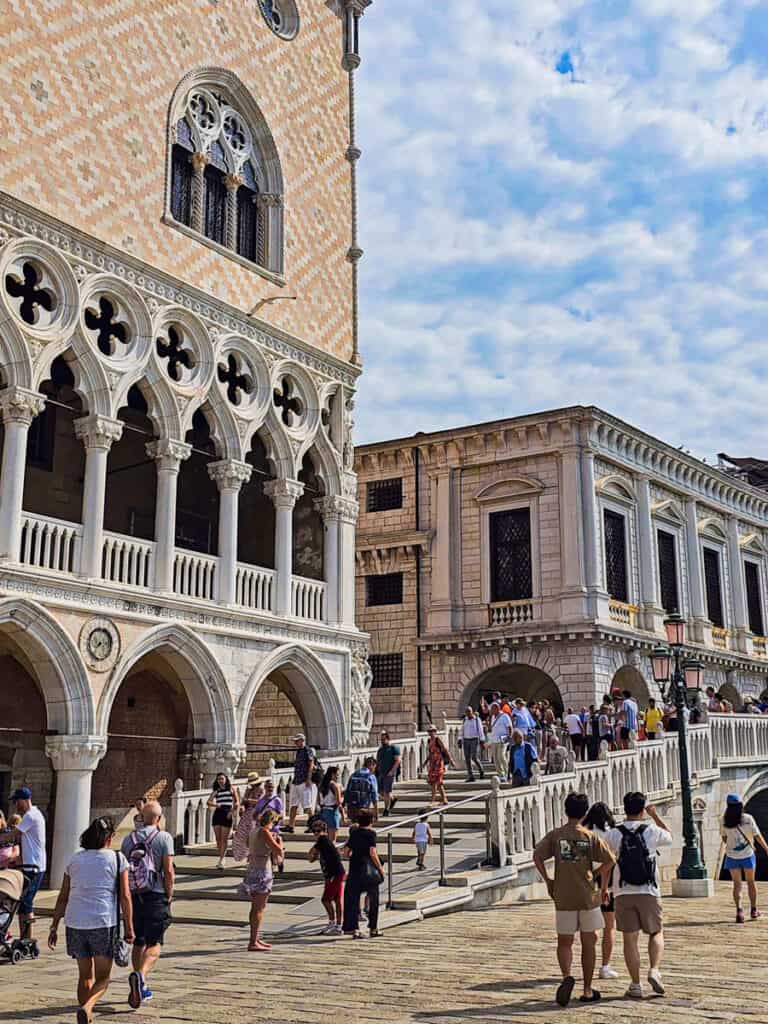
Since I enjoyed the palace so much, I wish I did a guided tour so I could have learned more of the history behind it. We were left to read information panels (not a lot of them) on our own – something that is very difficult to do when you travel with kids.
Here are a few guided tours we handpicked for you.
- Explore St. Mark’s Basilica & the Doge’s Palace after closing time, with exclusive after-hours access to both Venetian wonders.
- Discover a darker side of Venice with VIP access to the prisons and torture chambers of the Doge’s Palace, plus Casanova’s prison cell! Also includes skip the line to St Mark’s Basilica. See prices and availability here.
- Here’s a private tour with privileged access to Saint Mark’s Basilica, its panoramic terraces, and the Doge’s Palace. And this private tour version is made for families!
How To Beat The Crowds at The Doge’s Palace
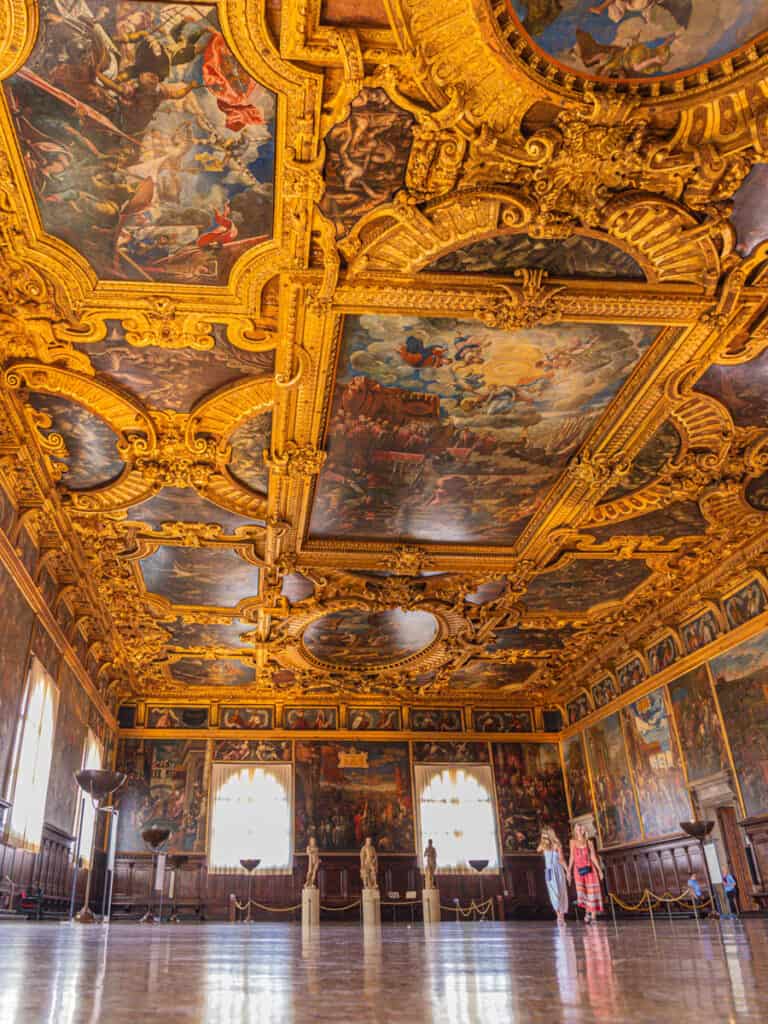
A top tip of ours is to make sure you book the first guided tour of the day or the timed entry tickets for 9am via Tiqets.
Arrive at least 15 minutes before hand and lineup to be one of the first into the palace. After security, you will arrive into the courtyard. You can see this once you’ve finished touring the inside as you’ll finish here. I recommend exploring the courtyard then.
You’ll want to head straight into the palace so you can get ahead of the crowds and explore most rooms on your own. We saw very few people for the hour that we were in there.
By the time we left at 10am the lines were growing and the people streaming in. If you want to get photos without crowds of tourists, this is the only way.
NOTE: You will have to check in any backpacks, so to reduce time, if you can, don’t take any in with you. We had to check mine in – but it was quick since there were no lines. Don’t forget to pick it up on your way out. I did and had to ask them to let me back in, and pass security again, to go get it!
What To See At The Doge’s Palace
Now you know a little bit about the history of the palace and how to visit it, let’s cover what hidden gems and marvels there are to see inside the Doge’s Palace…
1. Golden Staircase (Scala d’Oro)
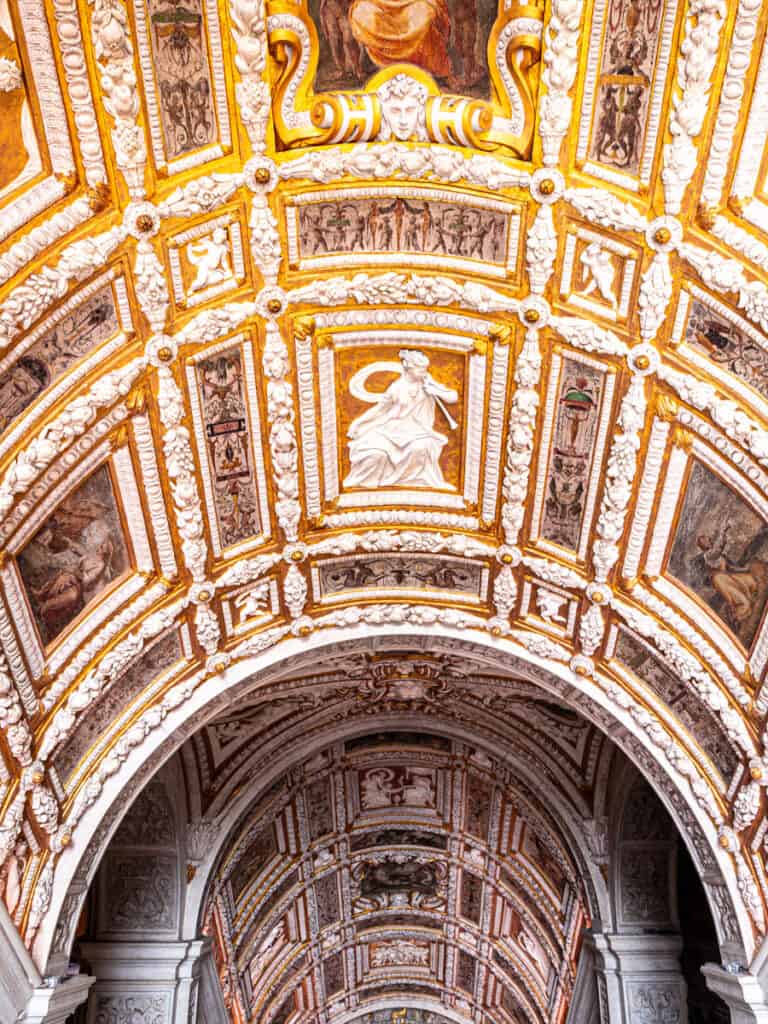
The Golden Staircase, also known as Scala d’Oro, is one of the most famous highlights within the Doge’s Palace.
This ornate staircase in Roman-style features a stunning arched stucco ceiling adorned with 24-carat gold leaf, creating an atmosphere of opulence and grandeur.
It was commissioned by Doge Gritti during the mid-1500’s, and designed by Jacopo Sansovino in the 1538, but was redesigned by Antonio Abbondi in 1559. It served as the passage leading to the Doge’s apartments and the Atrium Square, located in the heart of the palace.
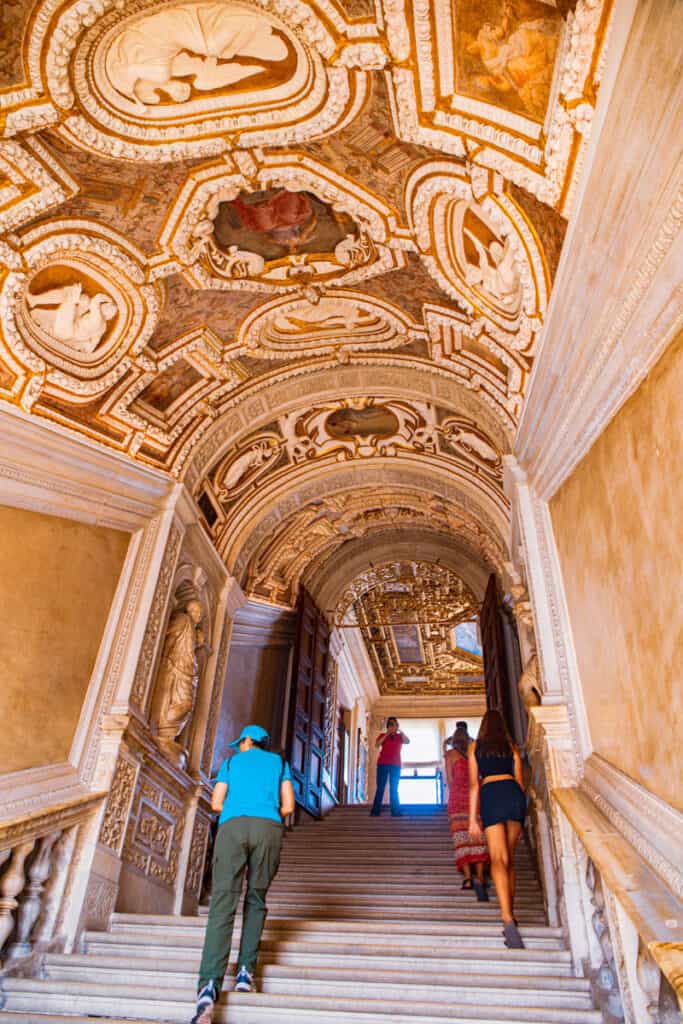
The Scala d’Oro not only showcases the exquisite craftsmanship of the Venetian Gothic style but also symbolizes the power and prestige of the Venetian Republic.
It was quite an impressive way to start the tour of the palace and spoke of the grandeur that was to come.
2. Museo Dell’Opera
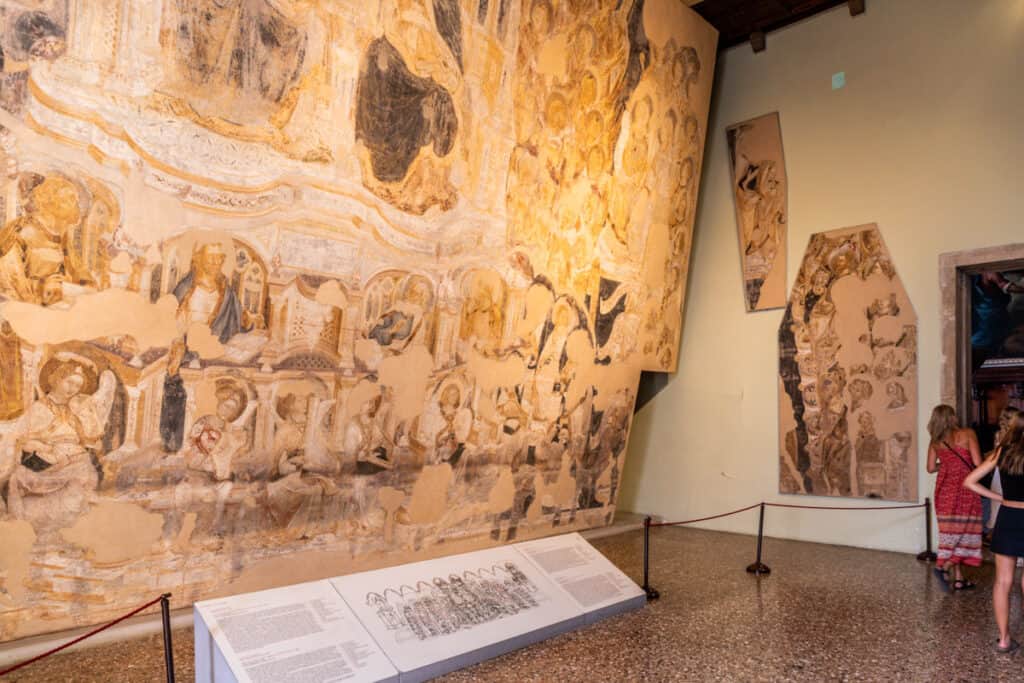
The Museo Dell’Opera holds a repository of artistic treasures and architectural fragments that tell the story of the evolution and restoration of the Doge’s Palace over the centuries.
Among its notable exhibits are six 14th-century capitals and columns from the lagoon-front arcade of the palace.
The Museo Dell’Opera offers a unique opportunity to learn more about the design, construction and restoration of the palace.
3. Armoury
The Armoury features over 2000 exhibits, showcasing the weaponry and armor used during the Venetian Republic. While some pieces were dispersed after the fall of the Republic, the Armory still contains valuable artifacts that provide insights into Venice’s military past.
You can see a large sword used for public executions in St Mark’s Square during the Middle Ages, as well as a “Devil’s Chest” which sets off four pistols when opened (don’t worry, it’s behind glass!)
4. Bridge of Sighs
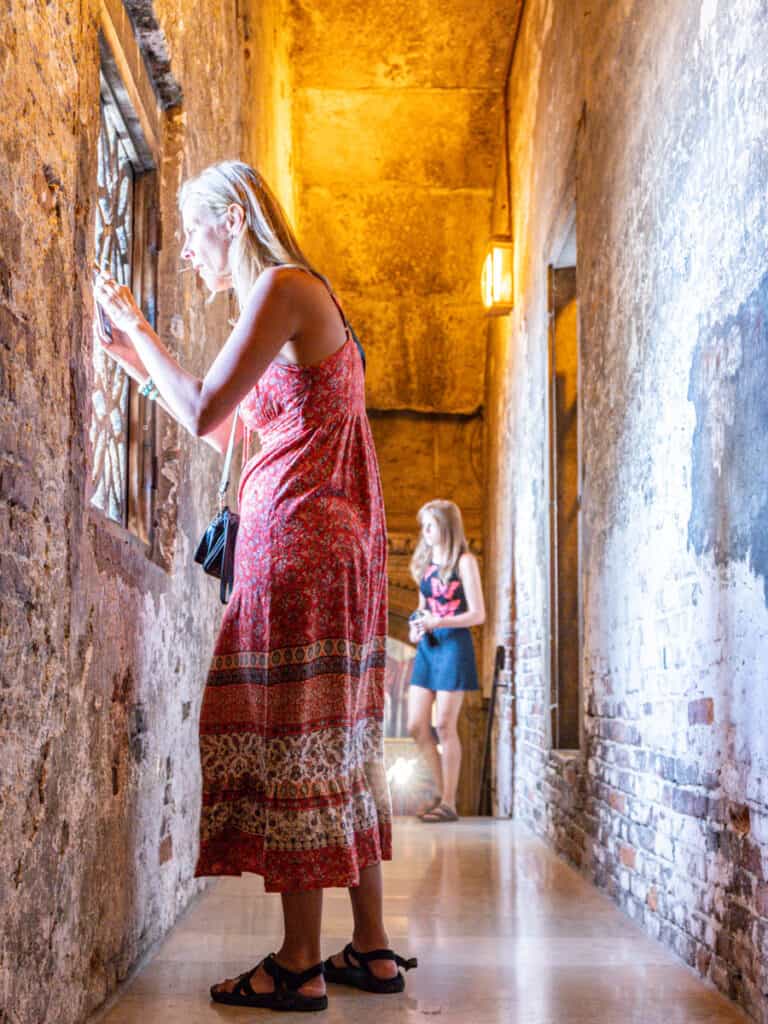
What was interesting to me – and I didn’t know before visiting – is that this grand palace was also used as a courthouse and prison. I love how the tour took you through the prisoner journey from where they were sentenced to where they were detained in the prison.
That included walking across (from the inside) the Bridge of Sighs, perhaps the most famous part of the palace.
This enclosed bridge, constructed in the 17th century, connects the Doge’s Palace to the New Prisons. It’s made of white limestone and features stone-barred windows that pass over the Rio di Palazzo.
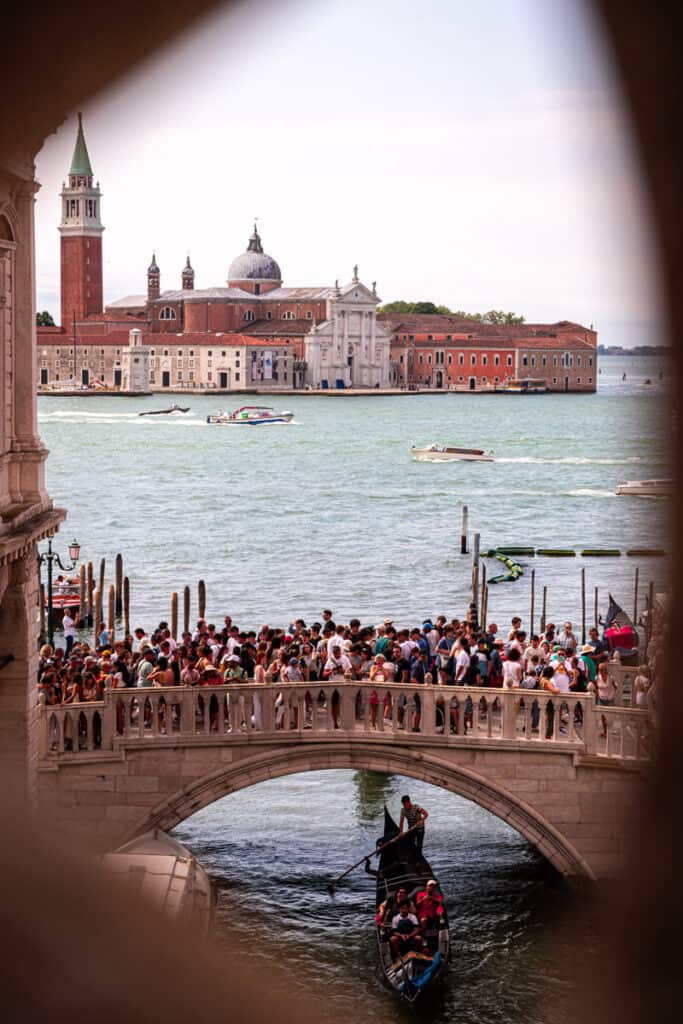
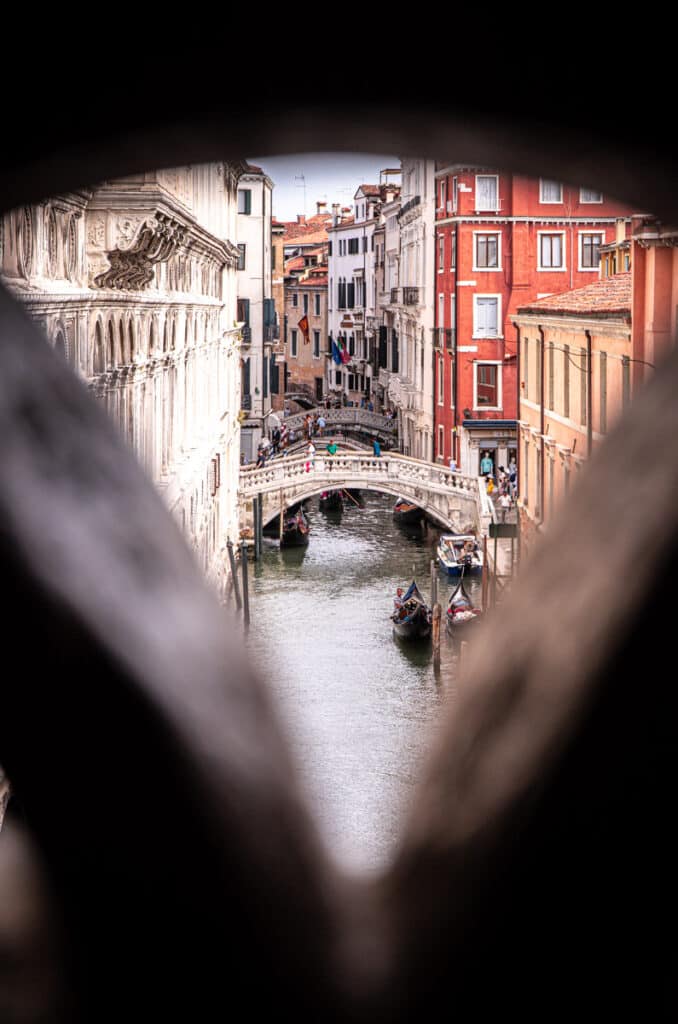
The bridge gained its name from the sighs of prisoners as they caught their last glimpse of Venice before being incarcerated. While it has been romanticized by poets and associated with love, its true purpose was to transport prisoners. Not very romantic at all.
I like how you first walked over the Bridge of Sighs before visiting the prisons. It really gave you a sense of that last look at Venice.
There is a one-way path through the inside bridge – you won’t miss the view out of both sides as when you return from the prison, you’ll cross through the other side.
5. Prisons
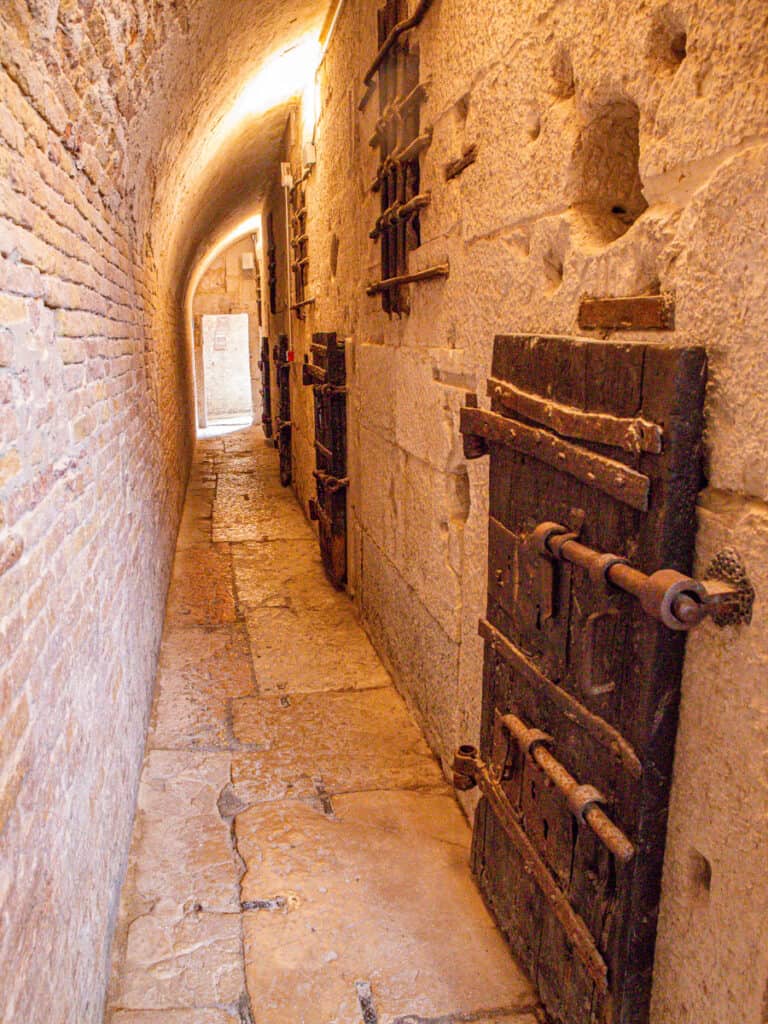
The prisons, known as the Piombi, were located beneath the palace’s roof and derived their name from the lead slabs that covered them.
These prisons housed prisoners awaiting trial or serving their sentences during the Venetian Republic. Exploring these dark corridors and cells offers visitors a glimpse into Venice’s judicial system and the harsh realities faced by prisoners in the past.
It was a great lesson for the girls to understand why we follow society’s laws and stay out of trouble!
The prisons are an integral part of the palace’s rich heritage and are worth seeing for their historical importance and atmospheric appeal.
6. The Chamber of Torment
The Chamber of Torment has a dark and haunting history. Also known as Sala del Tormento, this place was located in the basement of the palace and was used for interrogating and torturing prisoners during the time of the Republic of Venice.
Prisoners would be brought here and made to wait in complete darkness before their turn for questioning.
The Chamber of Torment stands as a stark reminder of the harsh judicial practices of the past. While disturbing, it is worth seeing as it offers a glimpse into the grim reality faced by prisoners.
Somehow, we missed this chamber, which I’m quite disappointed by. That’s the value of a guided tour, you won’t miss important things. You only know what you know!
7. The Doge’s Apartments
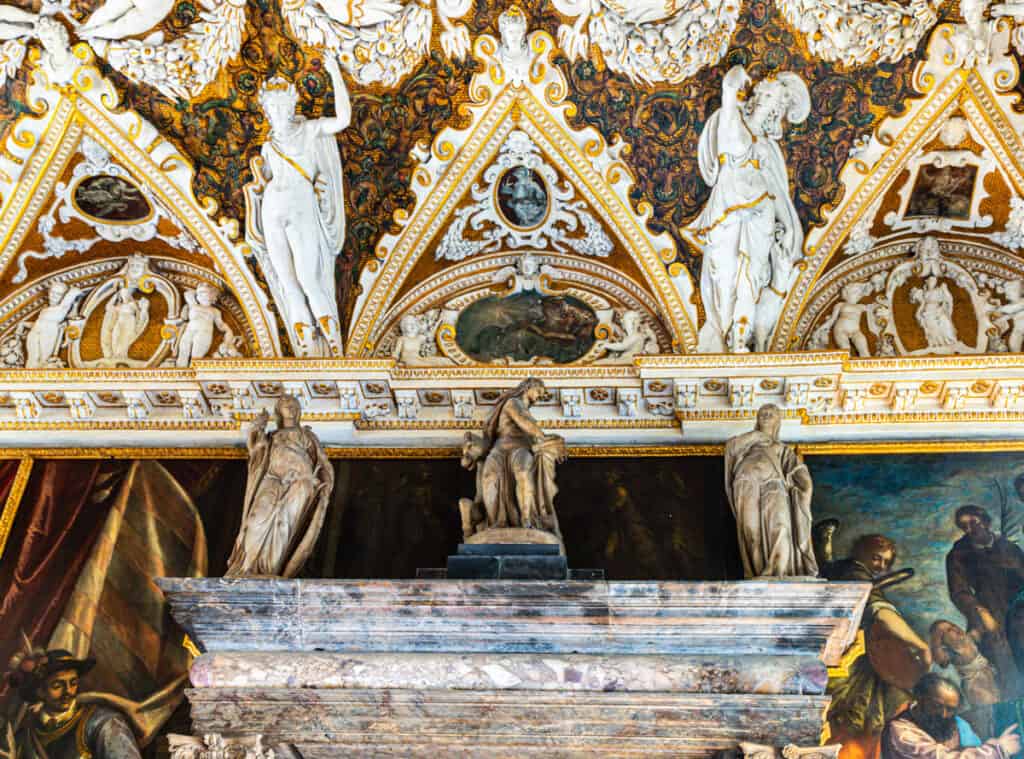
The Doge’s Apartments were the residence of the Doge of Venice, and are perhaps some of the most lavish rooms in the building.
Constructed in the 14th century, the palace underwent modifications and expansions over time. The exquisite Venetian Gothic architectural style is showcased in the apartments, adorned with ornate decorations and artwork.
8. The Great Council Chamber (The Sala del Maggior Consiglio)
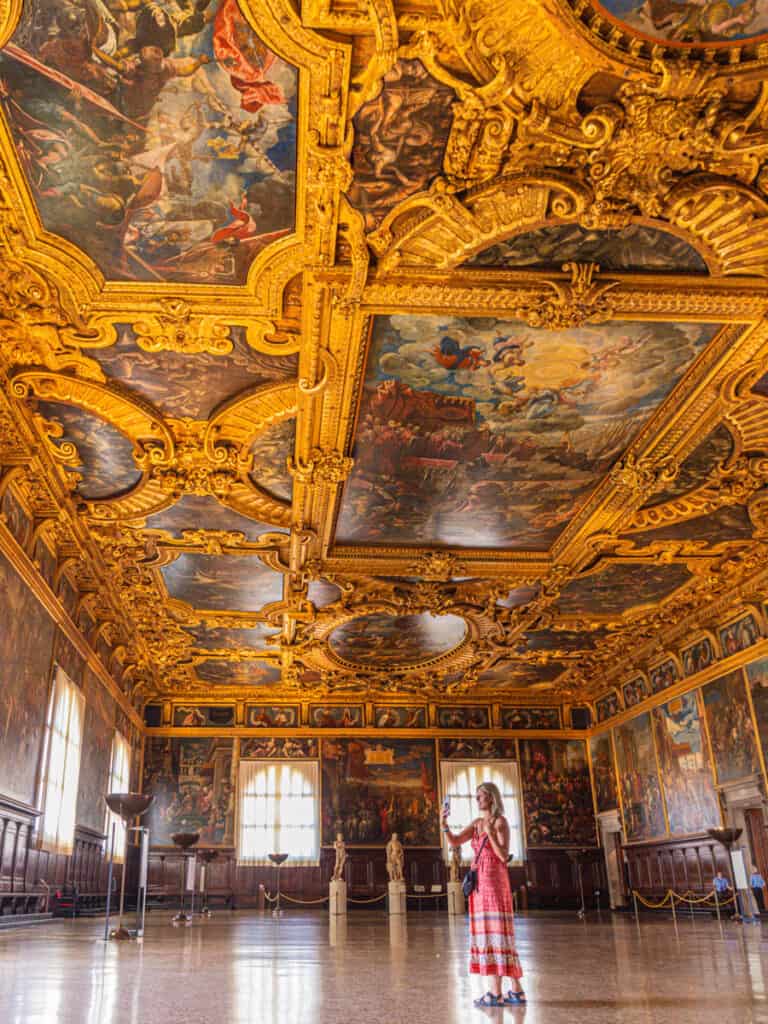
The Great Council Chamber, also known as the Sala del Maggior Consiglio, served as the meeting place for the Great Council of Venice, the political heart of the Republic of Venice from 1172 to 1797.
With its magnificent decoration and grandeur, the chamber reflects the power and influence of the Venetian aristocracy. It is adorned with frescoes by artists like Guariento and Tintoretto, showcasing Venetian artistry at its finest.
It’s said to be one of the most magnificent rooms you’ll see in Europe and apart from two other people who wandered in as we were leaving, we had it all to ourselves.
It’s here that important financial matters were decided, where the first phase of a doge election would take place, and where sentences for the prisoners were decided.
9. The Chamber of the Scrutinio (The Sala dello Scrutinio)
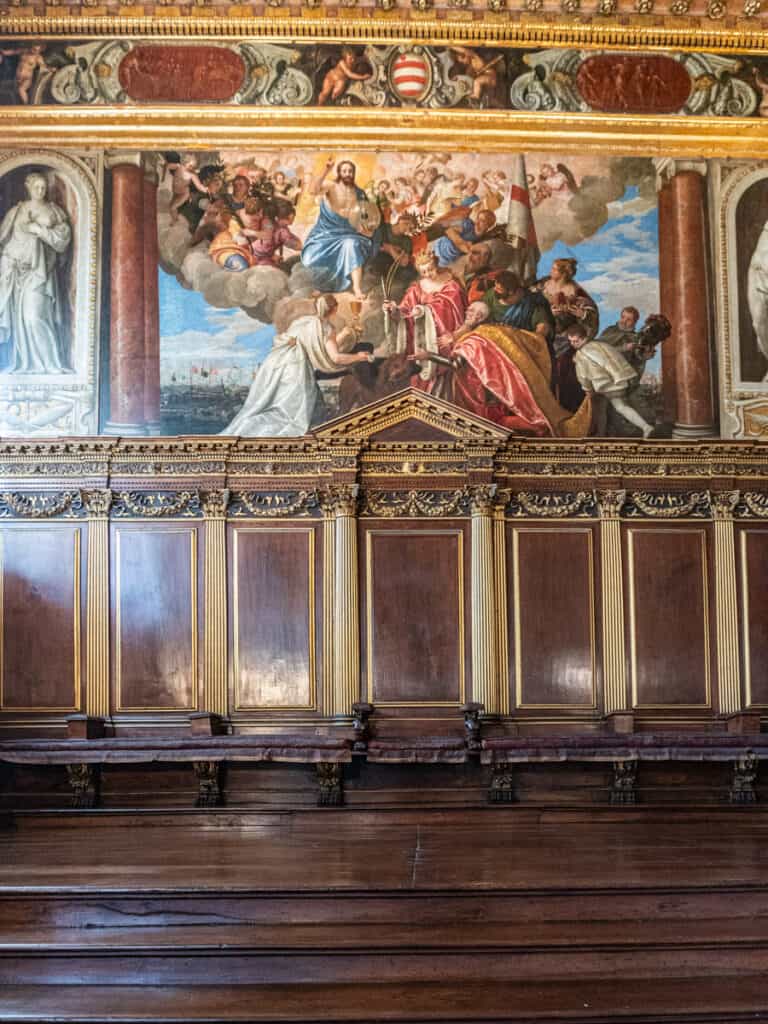
The Chamber of the Scrutinio, also known as the Sala dello Scrutinio, situated in the wing facing the Piazzetta and connected to the Sala del Maggior Consiglio, is a vast chamber constructed during the tenure of Francesco Foscari in the 1520s-1540s.
It served as a space for scrutinizing and counting votes during the meetings of the Great Council of Venice. The Chamber features magnificent architecture and splendid artwork, including a majestic triumphal arch created by Andrea Tirali.
10. The Doge’s Throne
This magnificent throne, located in the Hall of the College, was where the Doge, the elected leader of the Republic of Venice, would preside over important ceremonies and meetings.
The throne itself is a masterpiece of craftsmanship, adorned with intricate carvings and luxurious materials.
11. The Hall of the Council of Ten (The Sala del Consiglio dei Dieci)
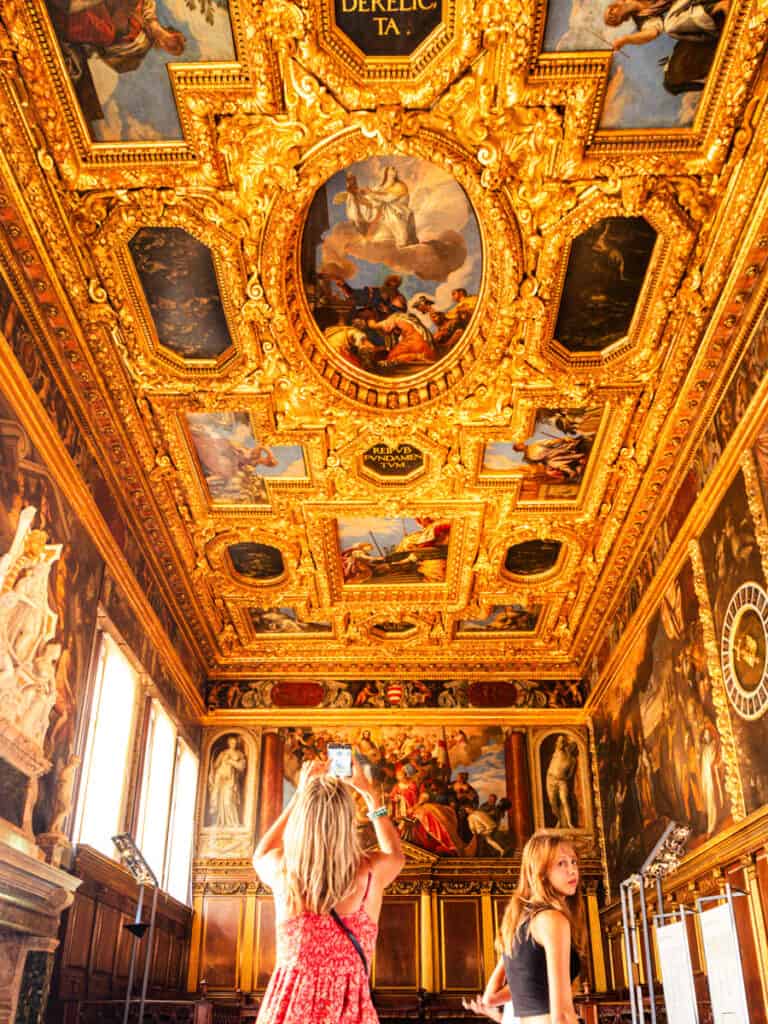
The Hall of the Council of Ten was a chamber that served as the meeting place for the Council of Ten, a powerful tribunal with exceptional powers, from 1310 to 1797.
Composed of ten members chosen from the Senate, the Council of Ten was responsible for maintaining order and security in Venice.
12. Senate Hall (Sala del Senato)
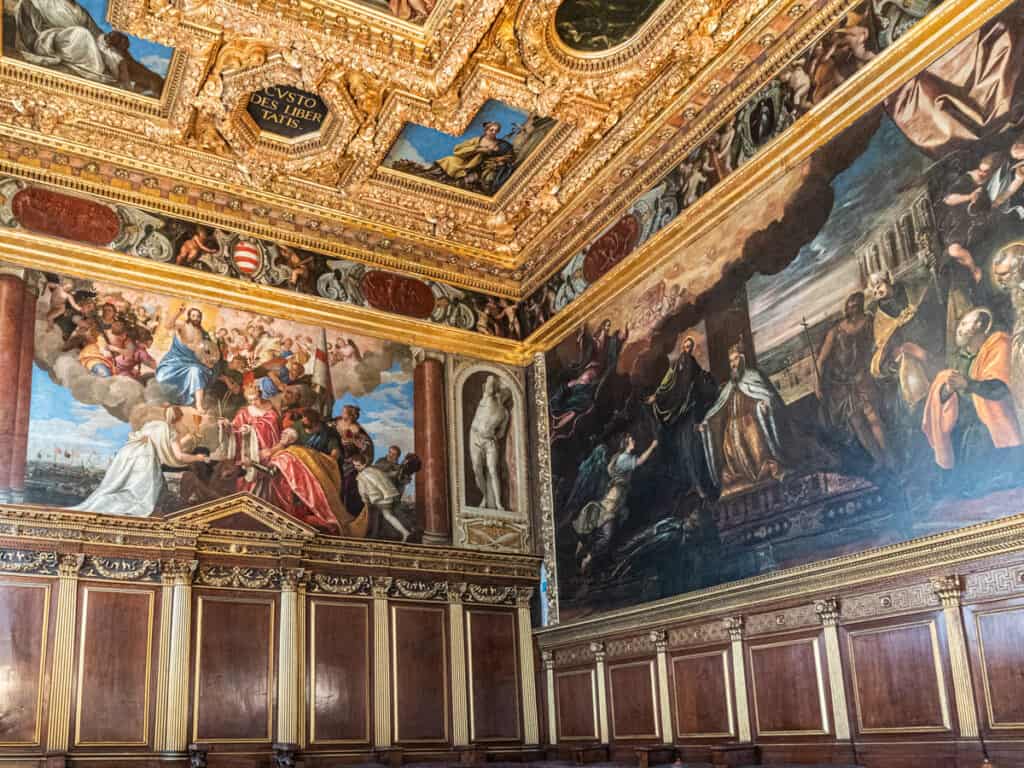
The Senate Hall was used by government bodies to make important foreign policy decisions, such as appointing new ambassadors. It served as the formal antechamber to more prominent rooms in the palace.
The ornate doors of the Senate Hall are framed with precious materials, adding to its grandeur.
13. Paper Gate (Porta della Carta)
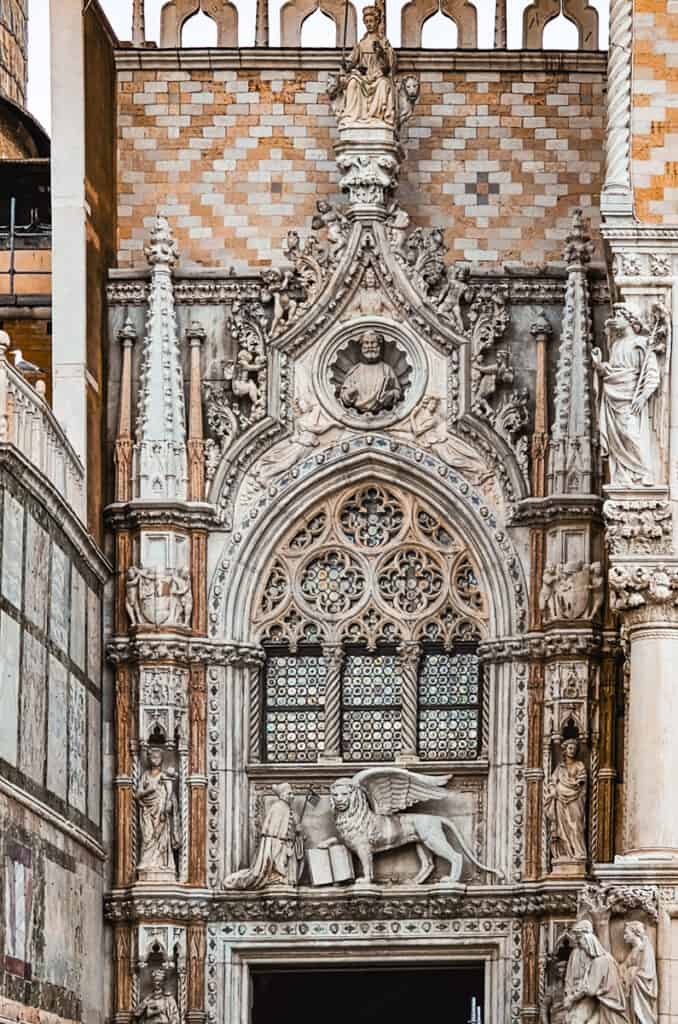
The Paper Gate is a remarkable architectural feature of the Doge’s Palace. Dating back to the 1400s, it showcases exquisite Late Gothic style in Venice.
It was designed by Giovanni and Bartolomeo Bon and serves as the main entrance to the palace and connects it to St. Mark’s Basilica.
Above the cornice, there is a depiction of Francesco Foscari, the Doge during its construction, kneeling before the Lion of St. Mark. The gate symbolizes the power and authority of the Venetian Republic.
14. Giant’s Stairway (Scala dei Giganti)
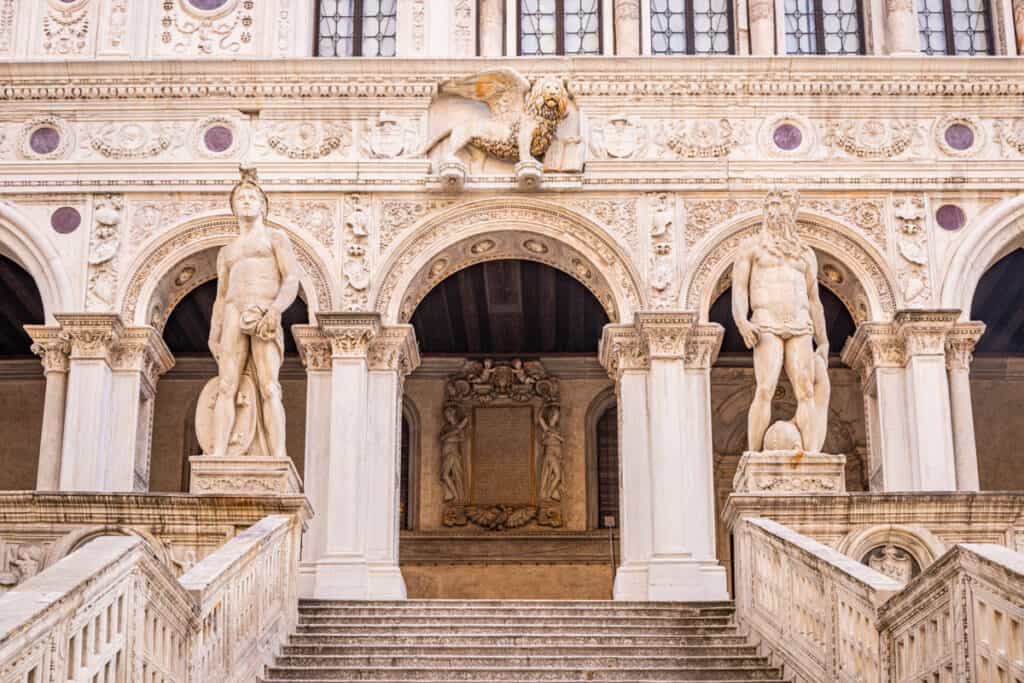
Another beautiful staircase worth checking out is The Giant’s Stairway, or Scala dei Giganti, which derives its name from the two immense marble statues of Mars and Neptune, created by Jacopo Sansovino in 1567.
These statues symbolize the power and dominion of the Venetian Republic. The Giant’s Stairway, which connects the courtyard to the ground floor, and is made out of marble.
Notice the intricate design on the steps, which is an old niello design. From the steps to the banisters to the railings, each piece of the staircase has been decorated with intricate reliefs and detailing.
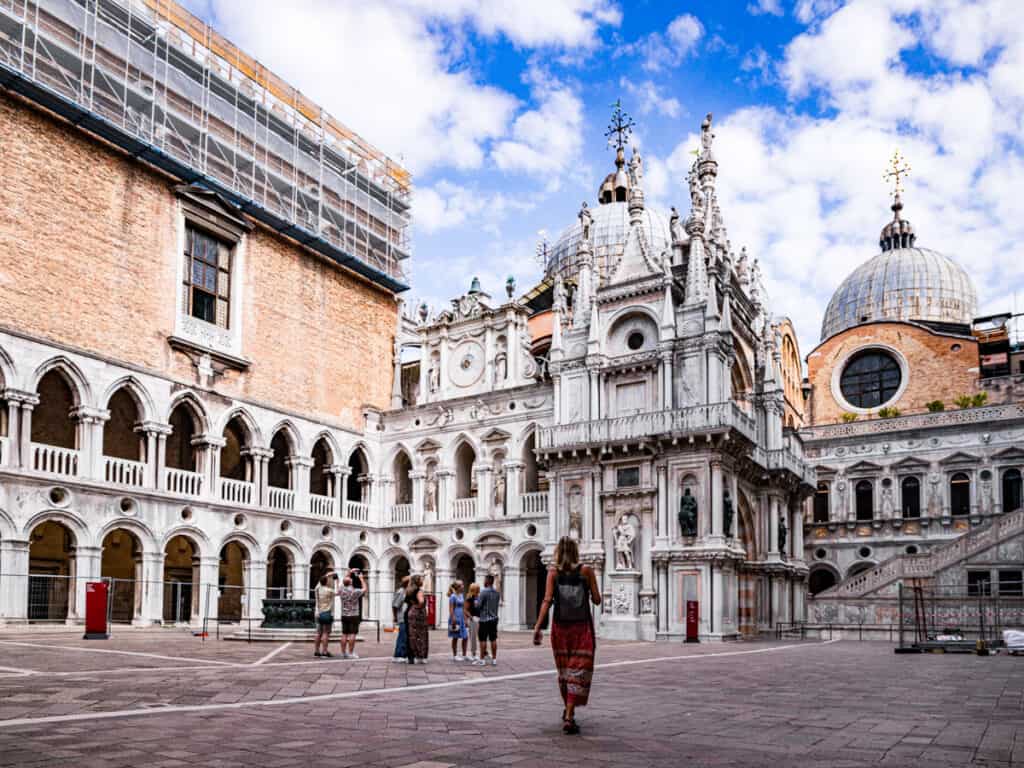
As you come out of the palace, you’ll come behind the stairway, so it will be on your left. We nearly missed it, and only saw it as we turned back as we were about to walk out the gates. It’s very impressive so don’t miss it!
Now is also a great time to admire the courtyard of the palace and the views of St Mark’s Basilica dome behind it.
15. Statues by Filippo Calendario
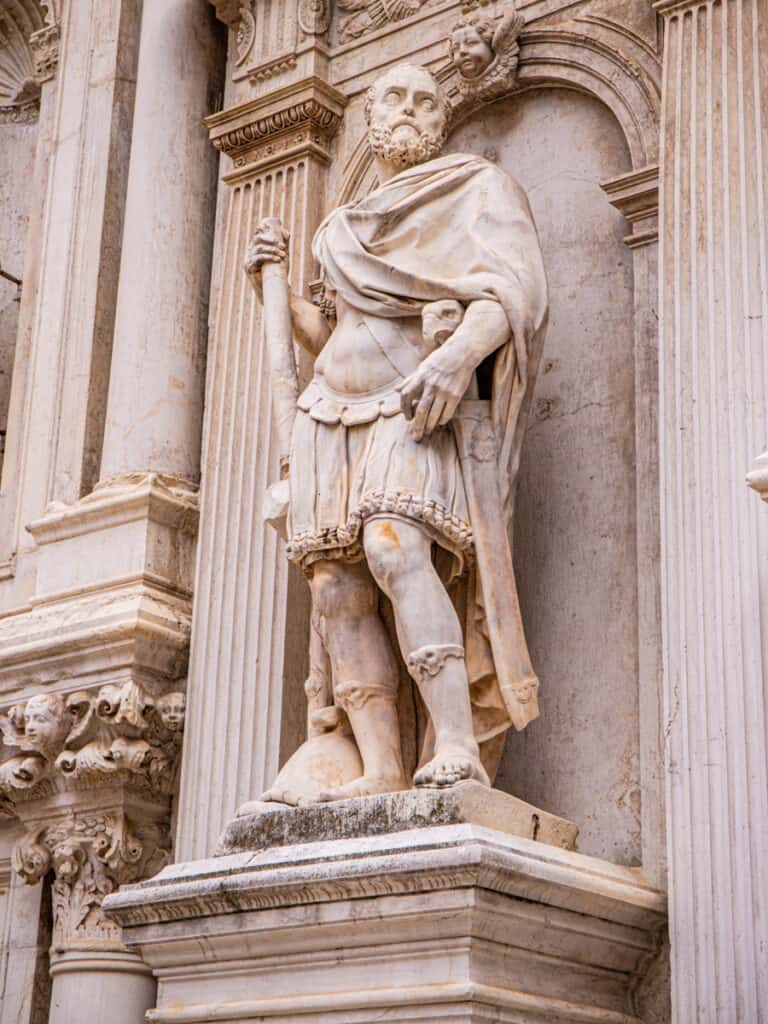
You will notice that every inch of the palace is decorated with either a fresco painting or a piece of marble art of some description.
Some of the most beautiful works of art are not on the inside of the palace but are on the outside.
Decorating the palace’s facade are the statues by Filippo Calendario, which adorn the corners of the palace’s facade facing the quay. They date back to the 13th century.
Calendario was a notable figure in Venetian Gothic sculpture and architecture, and his pieces add to the artistic legacy of Venice.
16. The Bridge of Sighs from the Outside
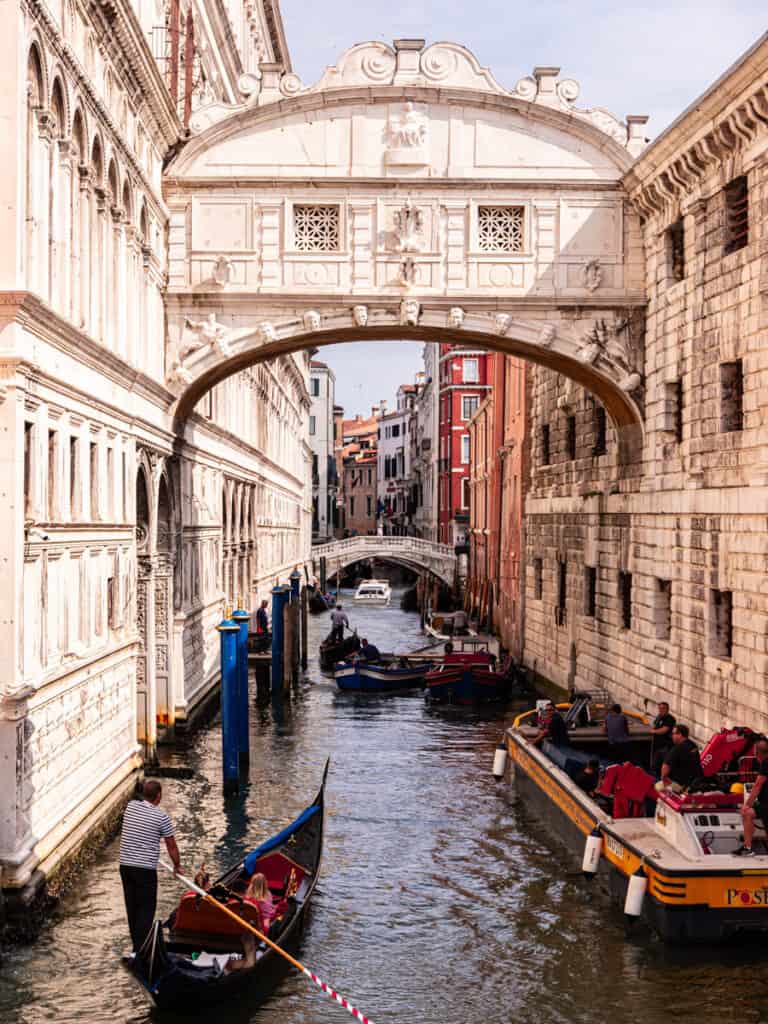
Once you’re finished exploring the inside of Palazzo Ducale, walk around to the front of the Grand Canal to the small bridge (will be filled with people) to look at the Bridge of Sighs from the outside.
We enjoyed looking at this after being inside it. It felt more relevant to us and the kids and deepened the perspective of the prisoners bidding farewell forever!
As it’s on the outside of the palace, this view is free and open to the public.
FAQs About Visiting The Doge’s Palace
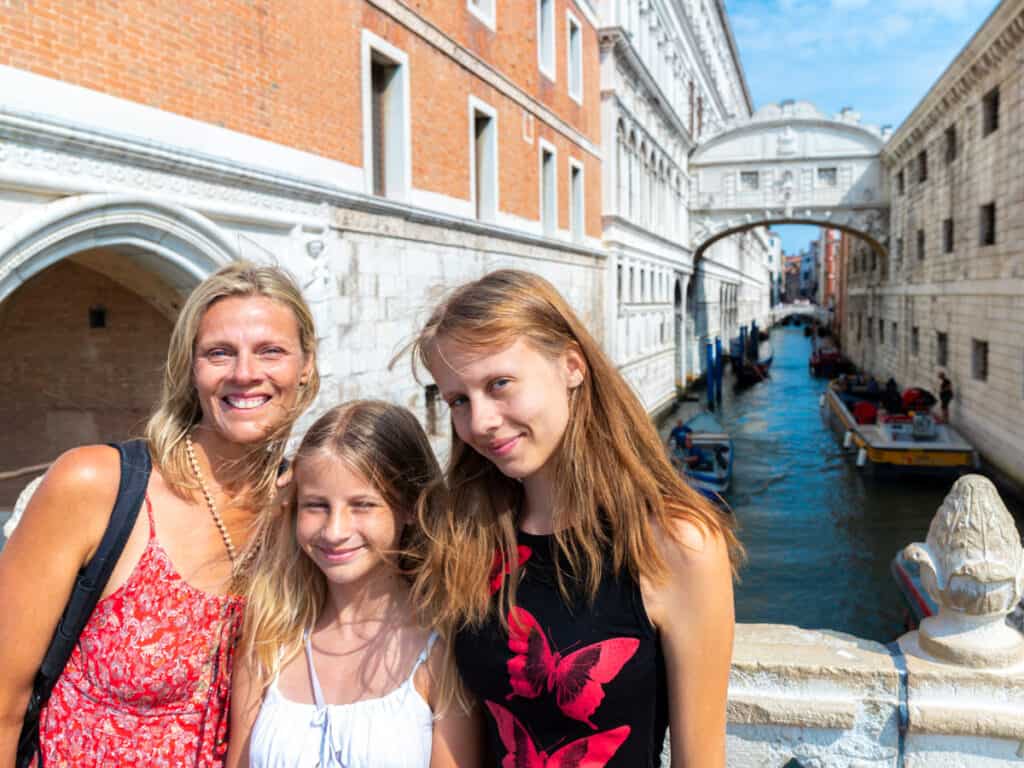
How long do you need to see all of the Doge’s Palace?
Most people spend between 2-3 hours in the Doge’s Palace. If you are booked onto a tour, you will be whisked around in an hour and 15 minutes, but you can explore the palace as your leisure afterwards.
Can you visit Doges Palace without a tour?
Yes, you can visit the Doge’s Palace without a tour and wander at your own pace. If you want to learn more about the history, you can also get an audio guide, however they are not as detailed as a guided tour.
Is there a dress code for Doge palace?
Yes, there is a strict dress code for the Doge’s Palace. You should dress modestly and wear long clothing – shorts and sleeveless shirts are not allowed, and you must remove your hat. Don’t wear anything with offensive writing.
Don’t miss these other helpful posts on travel in Venice. Here’s a one-day itinerary for Venice you can easily follow and top things to do in Venice. If you’re thinking of doing a walking tour, read our review of the Venice Highlights walking tour we did. And here is our entire two-week Italian itinerary from Rome to Venice.